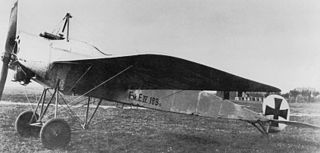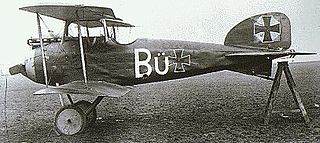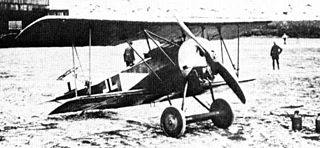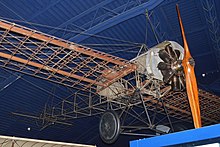
The Fokker D.VII was a German World War I fighter aircraft designed by Reinhold Platz of the Fokker-Flugzeugwerke. Germany produced around 3,300 D.VII aircraft in the second half of 1918. In service with the Luftstreitkräfte, the D.VII quickly proved itself to be a formidable aircraft. The Armistice ending the war specifically required, as the fourth clause of the "Clauses Relating to the Western Front", that Germany was required to surrender all D.VIIs to the Allies. Surviving aircraft saw much service with many countries in the years after World War I.

The Fokker Scourge occurred during the First World War from July 1915 to early 1916. Imperial German Flying Corps units, equipped with Fokker Eindecker fighters, gained an advantage over the Royal Flying Corps (RFC) and the French Aéronautique Militaire.

The Fokker E.V was a German parasol-monoplane fighter aircraft designed by Reinhold Platz and built by Fokker-Flugzeugwerke. The E.V was the last Fokker design to become operational with the Luftstreitkräfte, entering service in the last months of World War I. After several fatal accidents due to wing failures, the aircraft was modified and redesignated Fokker D.VIII. Dubbed the Flying Razor by post-war pulp-fiction writers, the D.VIII had the distinction of scoring the last aerial victory of the war.

The Fokker Eindecker fighters were a series of German World War I monoplane single-seat fighter aircraft designed by Dutch engineer Anthony Fokker. Developed in April 1915, the first Eindecker ("Monoplane") was the first purpose-built German fighter aircraft and the first aircraft to be fitted with a synchronization gear, enabling the pilot to fire a machine gun through the arc of the propeller without striking the blades. The Eindecker gave the German Army's Air Service (then the Fliegertruppen des deutschen Kaiserreiches) a degree of air superiority from July 1915 until early 1916. This period, during which Allied aviators regarded their poorly armed aircraft as "Fokker Fodder", became known as the "Fokker Scourge".

The Fokker E.I was the first fighter aircraft to enter service with the Fliegertruppe of the Deutsches Heer in World War I. Its arrival at the front in mid-1915 marked the start of a period known as the "Fokker Scourge" during which the E.I and its successors achieved a measure of air superiority over the Western Front.

The Fokker E.II was the second variant of the German Fokker Eindecker single-seat monoplane fighter aircraft of World War I. The E.II was essentially a Fokker E.I with the 75 kW (100 hp) Oberursel U.I 9-cylinder rotary engine, a close copy of the French Gnôme Monosoupape rotary of the same power output, in place of the E.I's 60 kW (80 hp) Oberursel U.0, but whereas the E.I was simply a M.5K with a 7.92 mm (.312 in) machine gun bolted to it, the E.II was designed with the weapon system integrated with its airframe.

The Fokker E.IV was the final variant of the Eindecker fighter aircraft that was operated by Germany during World War I.

The Morane-Saulnier L, or Morane-Saulnier Type L, or officially MoS-3, was a French parasol wing one or two-seat scout aeroplane of the First World War. The Type L became one of the first successful fighter aircraft when it was fitted with a single machine gun that fired through the arc of the propeller, which was protected by armoured deflector wedges. Its immediate effectiveness in this role launched an arms race in fighter development, and the Type L was swiftly rendered obsolete. The original Type L used wing warping for lateral control, but a later version designated Type LA was fitted with ailerons.

The Albatros D.I was an early fighter aircraft designed and produced by the German aircraft manufacturer Albatros Flugzeugwerke. It was the first of the Albatros D types which equipped the majority of the German and Austrian fighter squadrons (Jagdstaffeln) for the last two years of the First World War. Despite this, the D.I had a relatively brief operational career, having been rapidly eclipsed by rapid advances in fighter aircraft.

The Fokker D.I was a development of the D.II fighter. The D.I was also flown in Austro-Hungarian service as a fighter trainer aircraft under the designation B.III. Confusing the matter further, both the D.II and D.I arrived at the Front in German service at similar times, in July–August 1916. The main designer was Martin Kreutzer.

The Pfalz D.III was a fighter aircraft used by the Luftstreitkräfte during the First World War. The D.III was the first major original design from Pfalz Flugzeugwerke. Though generally considered inferior to contemporary Albatros and Fokker fighters, the D.III was widely used by the Jagdstaffeln from late 1917 to mid-1918. It continued to serve as a training aircraft until the end of the war.

The Halberstadt D.II was a biplane fighter aircraft developed and manufactured by German aircraft company Halberstädter Flugzeugwerke.

The Fokker D.VI was a German fighter aircraft built in limited numbers at the end of World War I. The D.VI served in the German and Austro-Hungarian air services.

The Fokker A.I was an "A-class" unarmed two-seat monoplane observation aircraft of the 1914-15 era early in World War I, powered as the earlier Fokker M.5 was, by a 58.8 kW (80 PS) Oberursel U.0 seven cylinder rotary engine, or umlaufmotor, a near-clone of the Gnome Lambda rotary engine of the same power output level — the same U.0 seven cylinder rotary engine version was used on all Fokker military monoplanes before the Fokker E.II Eindecker fighter's debut in 1915-16. The A.I aircraft resembled a substantially enlarged Fokker M.5, with a tall dorsal cabane structure to handle the triple sets of stationary flying and landing wires anchored to the wing panels' forward spar, each panel having fourteen wing ribs, and the similarly triple sets of wing warping cables attached to the rear spar. The A.I and earlier A.IIs were both built by Fokker and license-built by Halberstadt. The origins of the A.I, A.II and A.III were in a Morane-Saulnier Type H purchased from France. This led to the initial Fokker M.5 airframe designed by Martin Kreutzer, from which the larger A.I was derived. Fokker gave many aerobatic demonstrations in the M.5 on the eve of World War I. The M.8, was ordered as the A.I by the Fliegertruppe and between Fokker and Halberstadt, about 63 were produced.

The Fokker D.II was a German fighter biplane of World War I. It was a single-seat fighter aircraft developed before the Fokker D.I. It was based on the M.17 prototype, with single-bay unstaggered wings and a larger fuselage and shorter span than production D.IIs. Using a 75 kW (100 hp) Oberursel U.I, the D.II was underpowered, though the single 7.92 mm (.312 in) lMG 08 machine gun was normal for 1916. The German Army purchased 177.

The Fokker D.V was a German biplane fighter of World War I.

The Siemens-Schuckert D.I was a single-seat fighter built by Siemens-Schuckert Werke in 1916. It was a German copy of the French Nieuport 17 that was obsolete by the time it was available in numbers, so that it served mainly as an advanced trainer.

The Morane-Saulnier H was an early aircraft first flown in France in the months immediately preceding the First World War; it was a single-seat derivative of the successful Morane-Saulnier G with a slightly reduced wingspan Like the Type G, it was a successful sporting and racing aircraft: examples serving with the French army were used in the opening phases of the war.

The Siemens-Schuckert E.I was a German fighter aircraft, manufactured by Siemens-Schuckert.























